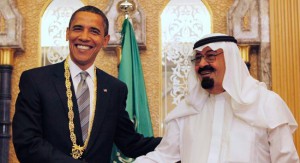Riyadh’s toughies in white tunic: an attack to the american shale oil?
 The title by which the Financial Times opened its edition last Thursday (January 15, 2015) could absolutely not leave us indifferent. In fact, the financial newspaper proclaimed in huge letters the surprising decision of the oil company Shell to cut the maxicontract boasting the value of 6.5 billion dollars drawn up with Qatar Petroleum. The reason is not that hard to find out. The dramatic reduction in price of the black gold, drifted by more than $100 a barrel last fall to about $50 of the last weeks, is bringing about a real earthquake within the energy industry, thus suggesting many operators to revise at least temporarily the planned investments. Considering, then, that the decision taken by the AngloDutch giant has to be added to the choices of the Norwegian Statoil of not taking advantage of the three licenses received to conduct drilling on the west coast of Greenland and to the decisions of the British Premier Oil to put off a project of over 2 billion dollars in the Falkland Islands, the result is certainly a bleak picture.
The title by which the Financial Times opened its edition last Thursday (January 15, 2015) could absolutely not leave us indifferent. In fact, the financial newspaper proclaimed in huge letters the surprising decision of the oil company Shell to cut the maxicontract boasting the value of 6.5 billion dollars drawn up with Qatar Petroleum. The reason is not that hard to find out. The dramatic reduction in price of the black gold, drifted by more than $100 a barrel last fall to about $50 of the last weeks, is bringing about a real earthquake within the energy industry, thus suggesting many operators to revise at least temporarily the planned investments. Considering, then, that the decision taken by the AngloDutch giant has to be added to the choices of the Norwegian Statoil of not taking advantage of the three licenses received to conduct drilling on the west coast of Greenland and to the decisions of the British Premier Oil to put off a project of over 2 billion dollars in the Falkland Islands, the result is certainly a bleak picture.
Much has been written about the reasons that led to a similar fall in the crude oil price. The most important element to highlight is certainly a strong alteration of the relationship between supply and demand. The full entry into service of the many open wells at the beginning of the new millennium, added to the unpredictable energy autonomy (only temporary, according to some) that the United States have achieved thanks to new and dangerous mining methods, has determined, at the same time, an extraordinary increase in the supply and a weakening in the demand. The latter, in fact, reflects not only the disappearance of the historic Stars and Stripes buyer, but also the prolonged period of weakness caused by the continuing economic crisis that plagues the socalled mature economies, and not only them, since that far 2008.
In the weeks that preceded the meeting of the major oilexporting countries, many analysts expected a conspicuous cut in the daily extraction of crude oil, with the precise aim of helping the rise of a price (we were at around $80 at that stage) considered too low both for profits to be realized and for the social and political stability of many countries. Actually, on November 27th of the last year, OPEC has decided, in the secrecy of his rooms, to leave the amount of oil extracted unchanged. In fact, the absence of unanimity, as stated in the rules of the organization, determines the perpetration of the provisions previously taken. In this regard, the position of inflexibility taken by the Saudis has certainly played a key role, compared to other countries probably eager, instead, to favor the rise in oil prices on international markets. What prompted Riad on this path remains a matter of debate. According to many, the Saudis would be helping their historic American allies, eager to put on the ropes numerous long standing enemies. These certainly include three countries that rely extensively, for their internal stability, on oil and gas export: the Vladimir Putin’s Russia, the postKhomeinist Iran, and the shaky Venezuela of President Maduro.
In our opinion, however, this explanation is incorrect because it overestimates the strength of relations between Washington and Riyadh, not even taking into account many significant aspects. First, the Saudis have a unique competitive advantage. The extraction of crude oil in the desert is indeed extremely convenient ($56 per barrel), especially when compared with that of the North Sea (over $25), or that obtained from shale (around the exorbitant amount of $70 per barrel). Secondly, the Saudis seem interested not only in the sale price, but also and above all in the defense of market shares. The decision not to cut the production is based on the presumption that in a market increasingly crowded of manufacturers and in which OPEC plays a less decisive role compared to the recent past, the cut in production could turn out to be a real boomerang for the countries that are part of the organization: that is, loss of market shares compared to a noninversion in the vertical fall in oil prices. The third and final piece of the puzzle is the most complicated, but also the most interesting. As Manilo Dinucci rightly pointed out some weeks ago in an interesting article published on the newspaper Il Manifesto, it is legitimate to ask why the boom of extraction with unconventional methods continues in the United States and Canada. The reason is that the Obama administration has set aside billions of dollars to this sector, thus making the extraction so profitable for operating companies, even with minimal profit margins, or in evident loss. The reason for this attention is due to the vast attempt of reindustrialization that the United States are pursuing with the aim of fighting the Chinese dominance in the manufacturing sector. Washington’s strategy is based on three assumptions: a) low labor costs; b) laughable business taxation; and c) minimum cost of energy. This last aspect is closely related to the unconventional extraction of oil. The logical question that arises is obviously to understand how far Washington will be willing to go. The persistence of a price per barrel below the threshold of $50 obviously approaches the breaking point. Something that Riyadh certainly does not overlook. As the Saudi Oil Minister reminded, referring to the Americans, “they will hurt themselves before we can feel any pain”. The truth is that there is no WashingtonRiyadh axis opposed to MoscowTeheranCaracas. Today there is simply a surplus of production calculated in 1.52 million barrels. The Saudis think a new tradeoff between supply and demand can be achieved by putting offside who extracts at higher prices, accepting less profits today and betting on a rebound tomorrow. And since they extract at one of the most affordable prices in the world and hold resources valued about $400 billion, they are likely to succeed in their attempt.
See also:






















